- Home
- Susan Wittig Albert
Queen Anne's Lace Page 2
Queen Anne's Lace Read online
Page 2
I finished running the July numbers, frowned at them for a moment, then decided that if I didn’t count all those extra expenses (which are really an investment in the building), the bottom line didn’t look all that bad. Cheered up a little, I found the file of tearoom menus that Ruby and Cass had emailed me for posting on our website, and began to study them. Khat and I were considering the merits of grilled chicken with carrot and couscous salad when Ruby came through the door from her Crystal Cave, which is also closed on Mondays. At six-foot-something in yellow sandals, she was dressed for her day off in a sleeveless yellow top and lipstick-red shorts. Her hair is the color of fresh carrots, finely frizzed, and today, her eyes were green (a sure sign that she was wearing her green contacts—otherwise, they may be blue or brown).
She leaned against the counter. “A little voice woke me up this morning telling me that today would be a good day to clean out the storeroom upstairs. If you’re not doing anything, why don’t you give me a hand?”
Cleaning out that storeroom had been on our joint to-do list for some time, but it had never seemed very urgent. “I am doing something.” I pointed at the computer screen. “I’m doing menus. And then the website.”
“You can do menus and the website later.” Ruby stroked Khat’s tawny fur and he began to purr. “There’s not all that much stuff in that storeroom. It won’t take more than a couple of hours.”
“And then what?” I asked. “We don’t really need the space, do we?”
Khat arched his back under Ruby’s hand, turning up the volume on his rumbling purr. “Of course we do,” Ruby said. “We can use it to store all the stuff we’re keeping under the stairs.”
“Then what will we put under the stairs?” There’s a bathroom there—well, a toilet and sink. And piles of junk. When you sit on the john, you’re staring at boxes and bins of our out-of-season decorations. Christmas lights, Halloween ghosts and goblins, Easter bunnies, stuff like that. “Most of our customers don’t use that bathroom,” I pointed out. “They use the restroom off the tearoom.”
“Yes, but sometimes people have to wait.” Ruby twiddled a frizzy lock of her red-orange hair. “There are times we could use a second bathroom. If we move the holiday decorations to the storeroom upstairs, we can put in a new vinyl floor and paint the walls. Maybe add a cabinet under the sink and some decent lighting, so it doesn’t look quite so much like a toidy in the Pecan Springs jail.”
“How do you know what a toidy in the Pecan Springs jail looks like?” I asked, interested.
Ruby rolled her eyes. “You know what I mean, China. Our customers will appreciate another bathroom. We’ll be killing two birds with one stone.”
It sounded to me like a whole flock of birds and a big basket of stones. Not to mention a lot of work. “Well, maybe,” I conceded. “But we don’t have the money to fix up the bathroom right now. And while the loft is air-conditioned, that storeroom isn’t. It’ll be an oven up there today. We’ll roast.”
Ruby pulled her gingery brows together. “China,” she said seriously, “that little voice is telling me that we ought to do this today. Lori doesn’t have classes on Monday, so we can haul that stuff out and not worry about getting in her way.” She bent over and planted a kiss between Khat’s charcoal ears. “You know what Benjamin Franklin said. Never put off to tomorrow what you can do today.”
“I’m more familiar with Mark Twain,” I countered. “Never put off to tomorrow what you can do the day after tomorrow.” I thought for a moment. “Or was it Oscar Wilde?”
The Victorian-style shopkeeper’s bell mounted to my front door tinkled pleasantly, and both of us turned around to look. But the door was locked and I had hung up the Closed sign to deter prospective customers. Nobody was there.
Khat arched his back, hissed, and jumped off the counter. Ruby frowned. “What’s wrong with him? And why is your bell ringing?”
“Dunno.” I shrugged. “Vibrations or something, I guess.” I waggled my eyebrows. “And maybe Khat is telling us that today isn’t a good day to clean out the storeroom.”
“Maybe he’s telling us that it is,” Ruby said decidedly. “Come on, China. Let’s do it.”
I pressed my lips together. When Ruby has an idea, I can either stand back and watch or be a good sport and join the party. After a moment’s reflection, I joined the party.
“If you insist.” I closed the menu file and shut down my laptop. I glanced down at Khat, who was sitting on the floor, gazing fixedly at the bell. “Come on, Khat,” I said. “You may find a mouse or two up there.”
The bell tinkled again, affirmatively.
“You see?” Ruby said in a meaningful tone. “It’s telling us that we’re supposed to do this.”
Looking back now with the wisdom of hindsight (funny how that works, isn’t it?), I wonder what would have happened if Ruby hadn’t listened to that little voice telling her that today was a good day to clean out that storeroom.
Or if I had said, Sorry, Ruby, but I absolutely positively have to get these menus uploaded today? How long would it have been before we discovered the wooden chest and the carton of old photographs? Maybe we wouldn’t have discovered them, ever. How would that have changed what happened?
Or if I had removed that bell.
We’ll never know, of course, because Ruby did hear that voice, and when she asked me to help, I did say yes. We did discover that chest, and after that, the photos. And the bell continued to ring.
And thereby hangs a tale.
* * *
• • •
BUT before I tell you what happened when Ruby and I went upstairs, it might be helpful if we took a few moments for introductions. If you’re a regular visitor to Thyme and Seasons, you know who we are and what we’re all about, so you have my permission to skip the next dozen or so paragraphs. If you’re new to Pecan Springs or just want to see if anything’s changed since the last time you were here, you’re invited to read on.
My name is China Bayles. In a previous incarnation, I was a criminal defense attorney with a large Houston law firm that catered to big bad guys with bottomless pockets who could hire our top-dollar dream-team defense. There were a lot of things I enjoyed about being a lawyer—and yes, money was certainly one of them. In those days, I was as ambitious and greedy as anyone else and willing to fight for my place on the ladder with whatever weapons it took. But after spending a decade of my life in that knock-down, drag-out environment, I began to wonder whether the justice I was engaged in seeking was the kind of justice we needed in this world—and whether Houston was the place I wanted to live for the rest of my days.
When the answers to both of these urgent questions finally came up no, I turned in my resignation, cashed in my retirement account, and bailed out. I landed in Pecan Springs, a small, friendly town just off I-35, halfway between Austin and San Antonio, at the eastern edge of the Texas Hill Country. I bought a building on Crockett Street and opened an herb shop I called Thyme and Seasons. When people ask me “Why herbs?” I give them the short answer: “Because plants don’t talk back.” When they ask “Why Pecan Springs?” I reply, “Because it seemed so crime-free and peaceful.”
And then I laugh out of the other side of my mouth, because while Pecan Springs is a great place to live, it is not and never has been crime-free. Don’t be fooled by the cozy images you see in the glossy Why You’ll Love to Visit Pecan Springs! brochures handed out by the Chamber of Commerce. Our nice little town has its fair share of crime, just like every other nice little town, everywhere—maybe even a little more, since we’re conveniently located in the I-35 Corridor, the narco-corridor, some call it: the main artery for the nation’s south–north drug trade. If you come here expecting Mayberry, you’ll be disappointed.
Pecan Springs and Thyme and Seasons were just the first of several major earthquakes in my life. After years of insisting that marriage required too m
any compromises, I married Mike McQuaid, whom I had met years before in a Houston courtroom. McQuaid is a former homicide detective, currently a private investigator with his own firm (McQuaid, Blackwell, and Associates) and an adjunct professor on the Criminal Justice faculty at Central Texas State University. We are the parents of two great kids. McQuaid’s son, Brian, will be a sophomore at the University of Texas this fall, majoring in environmental science. He lives with his girlfriend in Austin. Caitlin, my fourteen-year-old niece and our adopted daughter, lives with McQuaid and me in a big Victorian house on Limekiln Road, about a dozen miles west of Pecan Springs. We share the place with a gloomy basset hound named Winchester, a grizzled orange tomcat named Mr. P, Caitlin’s flock of chickens, and a legion of fugitive lizards escaped (or descended) from Brian’s collection of reptiles.
And then there’s Ruby. She is my business partner, sidekick, and owner of the Crystal Cave, the only New Age shop in Pecan Springs. Together Ruby and I jointly own and manage the tearoom behind our shops (Thyme for Tea) and a catering service we call Party Thyme. We also co-own (with Cass Wilde) the Thymely Gourmet, which delivers packages of healthy precooked food to upscale singles who want to eat right but don’t have the time (or don’t know how) to cook. Ruby has two grown daughters and a granddaughter, although you’d never know it to look at her. After an early divorce, she has managed to stay unmarried, although she is partial to intelligent men and cowboys. Just now, she is seriously dating a very nice guy named Pete who manages an olive ranch, a relationship that is complicated by the fact that the ranch is a couple of hours away and Pete’s job doesn’t allow him a lot of free time.
As you might guess from the fact that she owns a New Age shop, Ruby’s lifelong passions include astrology, tarot, and the Ouija board. I sometimes imagine the interior of her mind as a large crystal ball, with images materializing out of the shadows, disappearing, and then reappearing as something else entirely. Sorry if that sounds snarky—it’s not intentional. I admire Ruby’s intuition and empathy. She can actually scan people’s thoughts, although “off” is her default position on this ability. (She says she doesn’t like to pry into her friends’ secret lives.) I’ve known her to come up with some startling insights, based on ways of understanding the world that have nothing to do with the linear logic within which the rest of us poor mortals are trapped. While for me (and probably you), two plus two will only ever equal four, Ruby can just as easily make it eighteen-and-a-half—and more often than not, she’s right. Wacky, but right.
This might also be a good time to introduce you to our building, for it is a character in this story, too. As I said, I didn’t know much about 304 Crockett Street when I bought it, except that it was built of native Texas limestone sometime after the Civil War. In its first incarnation as a residence, it seems to have had two large rooms in the front, two behind, the loft above, and that lovely veranda across the front. There was a large garden on the east side of the house, and a stone stable for horses at the rear, on the alley.
Buildings change through time, just as people do, and the occupants have left their mark on this one, inside and out. At some point, a frame kitchen was added across the back of the house, the upstairs loft was partitioned into bedrooms, the veranda was removed, and the stable was converted to a garage. Later still, an architect bought the place and completely redesigned it. He turned the front two rooms into his office and studio, the back two rooms plus kitchen into an apartment for himself, and the stone stable-garage into a lovely guest cottage.
Ruby and I have changed this building, too. Her Crystal Cave takes up one of the front two rooms, and Thyme and Seasons the other. I lived in the architect’s apartment until I married McQuaid. Now, our tearoom occupies that space, and we’ve expanded and modernized the kitchen. The guest cottage has become a bed-and-breakfast—or a classroom for our cooking classes, when it isn’t occupied. The loft upstairs has had a full makeover. It is now Lori Lowry’s textile arts studio.
The loft was one of my better ideas, if I do say so myself—although the renovation was more extensive than I’d originally planned. The old wooden staircase had to be brought up to code (building inspectors are fussy about things like fire exits). The extra air-conditioning required some serious rewiring, and the windows had to be replaced. The flimsy interior partitions came out, revealing an expansive room with a pine floor and cypress rafters. There wasn’t enough light, so I had the contractor install a row of skylights in the roof and enough track lighting to comfortably illuminate the whole space.
The loft seems almost custom-designed for Lori’s studio and teaching space. The center part of the floor is filled with four floor looms, several tabletop looms, a couple of rigid heddle and inkle looms, a warping reel, and a half dozen spinning wheels. (Some of this equipment is on loan from members of the local weaving guild, who are Lori’s friends and supportive of her work.) Lori installed shelves along one wall and filled them with an assortment of rainbow-colored yarns and threads and fleeces ready to be spun, a delicious temptation for Khat, who loves to play with the tag ends of yarn when he sees them dangling. She’s turned the other walls into a well-lit gallery for her woven pieces and those created by her students and members of the local weaving guild. The whole place is totally gorgeous.
Which brings us to that storeroom.
* * *
• • •
WHEN the loft was renovated, I didn’t get around to doing anything with the old storage room at the back. It’s been a handy place to stash junk, some of it mine and Ruby’s, some of it left over from earlier occupants. The loft is air-conditioned, but the storeroom isn’t. When I propped the door open that morning so Ruby and I could work in it, the rush of heat felt as if it had accumulated from uncounted summers past. It was hotter than the dickens—and dark as the inside of a cow, until I remembered that there was a bare bulb hanging from the ceiling. I reached up, found its chain, and yanked it.
The naked bulb revealed a shadowed, low-ceilinged space running the full width of the building, about six feet wide, with shelves along the back wall. It smelled of musty old papers and summer’s heat, with an oddly sharp top note of lavender and the elusive bouquet of hot dust and dead mouse. I expected Khat to rush in, eager to discover if there were any survivors (mice, that is) who might require his immediate attention. But oddly, he put one paw inside the door, took a sniff, and then decided he had urgent business elsewhere.
“Wonder what got into him?” Ruby asked as he zoomed past her at warp speed and vaulted down the stairs. Wrinkling her nose, she stepped into the storeroom. “Is that lavender I’m smelling?” Not waiting for an answer, she pulled out a cardboard box. “What’s this?”
I opened the box and peeked in. “It’s the extra craft supplies from that papermaking workshop we did a couple of years ago. I thought we gave it to the preschool over on Elm Street.”
Ruby picked up the box. “That’s where it’s going now. I’ll put it at the top of the stairs. Could you see what’s in that crate? Maybe it’s something we can throw away.”
And that’s how it went for the next couple of hours. We worked our way down the length of the storeroom, opening boxes and bags, identifying the contents, and making executive decisions. Some of the stuff went to the Dumpster in the alley, some of it went back on the shelves (neatly!), and some of it was going to Goodwill. The curtains from my former apartment, for instance, along with some pots and pans, a rolled-up section of carpet, Brian’s old goalie mask, and a couple of boxes of games and puzzles—all bound for Goodwill.
I was beginning to feel like an archaeologist on a dig, for as we burrowed deeper into the storeroom, we seemed to be moving back in time. I discovered a Life magazine featuring the assassination of JFK, several copies of the Pecan Springs Enterprise dating back to the 1950s, a box of vinyl World War II–era records (Bing Crosby, Glenn Miller, the Andrews Sisters) that might be worth something at a yard sale, and a metal
advertising sign for Coca-Cola that said Refreshing Fountain Drink, just 5¢! A collector might want that.
And then it got even more interesting. I turned up a 1930s Shirley Temple doll with only one hand but most of her curly blond hair; a campaign button for Franklin Roosevelt’s first run for the presidency in 1932; and—folded into a cardboard dress box between several layers of tissue paper—a slinky silver flapper dress from the 1920s, with a silver headband and a red feather boa.
“Omigod,” Ruby breathed, when I opened the box. “Let me see that dress, China! It’s gorgeous!”
I held it up. It was made of some sort of sheer metallic fabric with skinny spaghetti straps and rows of layered silver tassels from the deep vee neckline to the hem. “It’s totally you, Ruby,” I said. “And it looks just your size. You have to try it on.”
Ruby’s eyes were shining. “Oh, wow,” she breathed, and snatched it out of my hands. A few minutes later, she was back, a vision in silver tassels, her carroty frizz set off by the silver headband. “Twenty-three skidoo,” she said, twirling the red feather boa. “Perfect for Halloween, don’t you think?”
“You are the bee’s knees,” I said admiringly. “So now that we’ve found your Halloween costume, we can quit. Right?”
“Nah,” she said. “We’re almost to the end. I’ll change and be right back. Bet we can finish in a half hour.”
“Okay,” I said, and went back to work.
There was more junk and more trips to the Dumpster, but more goodies, too. A copy of the Austin Weekly Statesman dated November 7, 1912, announcing Woodrow Wilson’s election as president. A framed photograph of the 1906 San Francisco earthquake. A wooden stereopticon with a set of cards illustrating battles of the Spanish-American War. A cardboard carton printed with the words Corticelli Silk Threads, Florence, Massachusetts, and a picture of a kitten playing with a spool of thread. The carton was filled with old sepia-toned snapshots from around the turn of the century, judging from the costumes and the way the women wore their hair. On top was a photograph of a man, a woman, a baby, and a pretty young girl, sitting in an old-fashioned porch swing on what looked like the veranda right here at 304 Crockett Street. The man, smiling happily, had one arm around the woman’s shoulders. She was holding a tiny, blanket-wrapped baby in her arms. The girl, dressed in a lacy pinafore, was holding a kitten. A shaggy dog lay on the porch beside the swing, and an old-fashioned bicycle leaned against the railing.

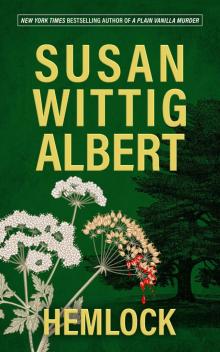 Hemlock
Hemlock Chile Death
Chile Death The Tale of Briar Bank
The Tale of Briar Bank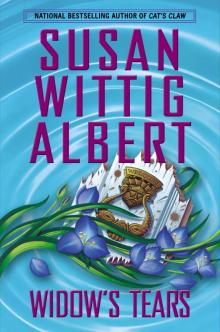 Widow's Tears
Widow's Tears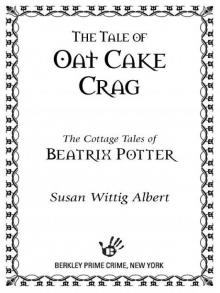 The Tale of Oat Cake Crag
The Tale of Oat Cake Crag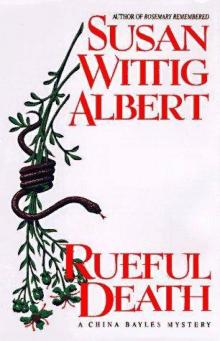 Rueful Death
Rueful Death Bittersweet
Bittersweet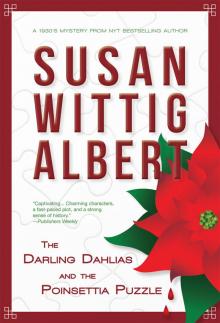 The Darling Dahlias and the Poinsettia Puzzle
The Darling Dahlias and the Poinsettia Puzzle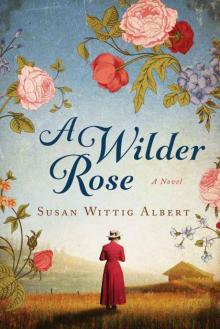 A Wilder Rose: A Novel
A Wilder Rose: A Novel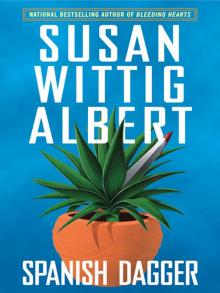 Spanish Dagger
Spanish Dagger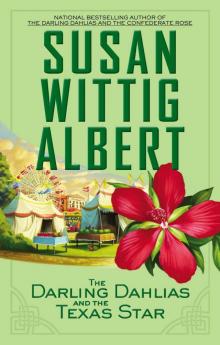 The Darling Dahlias and the Texas Star
The Darling Dahlias and the Texas Star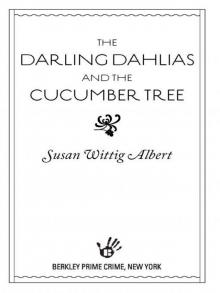 The Darling Dahlias and the Cucumber Tree
The Darling Dahlias and the Cucumber Tree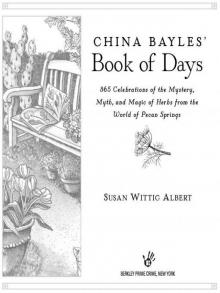 China Bayles' Book of Days
China Bayles' Book of Days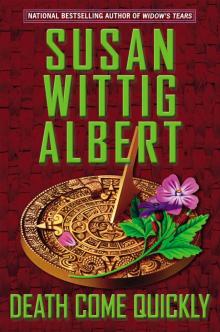 Death Come Quickly
Death Come Quickly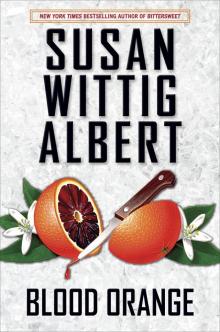 Blood Orange: A China Bayles Mystery
Blood Orange: A China Bayles Mystery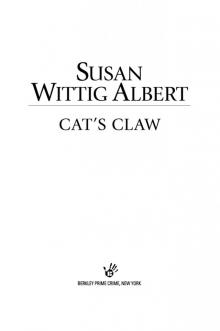 Cat's Claw
Cat's Claw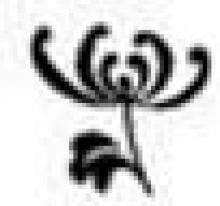 The Darling Dahlias and the Naked Ladies
The Darling Dahlias and the Naked Ladies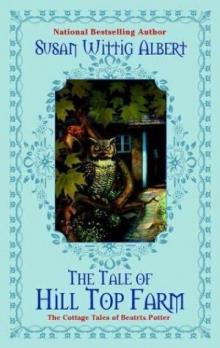 The Tale of Hill Top Farm
The Tale of Hill Top Farm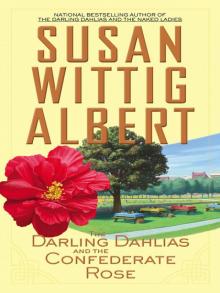 The Darling Dahlias and the Confederate Rose
The Darling Dahlias and the Confederate Rose The Darling Dahlias and the Silver Dollar Bush
The Darling Dahlias and the Silver Dollar Bush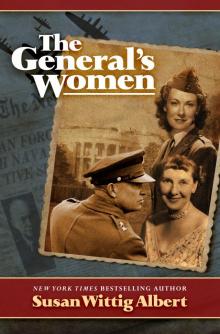 The General's Women
The General's Women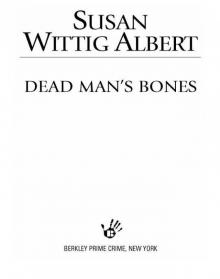 Dead Man's Bones
Dead Man's Bones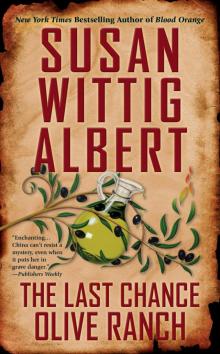 The Last Chance Olive Ranch
The Last Chance Olive Ranch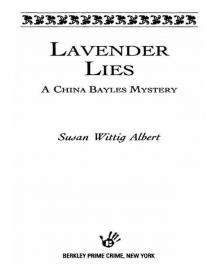 Lavender Lies
Lavender Lies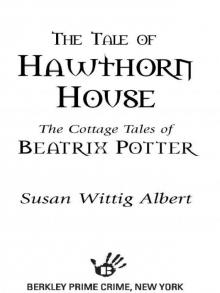 The Tale of Hawthorn House
The Tale of Hawthorn House The Tale of Castle Cottage
The Tale of Castle Cottage Rosemary Remembered - China Bayles 04
Rosemary Remembered - China Bayles 04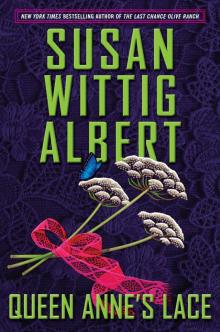 Queen Anne's Lace
Queen Anne's Lace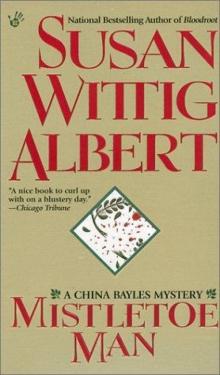 Mistletoe Man - China Bayles 09
Mistletoe Man - China Bayles 09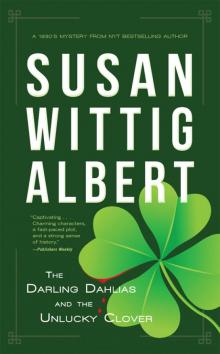 The Darling Dahlias and the Unlucky Clover
The Darling Dahlias and the Unlucky Clover Mourning Gloria
Mourning Gloria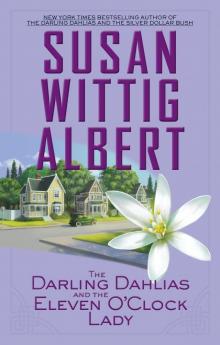 The Darling Dahlias and the Eleven O'Clock Lady
The Darling Dahlias and the Eleven O'Clock Lady